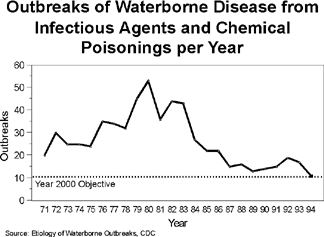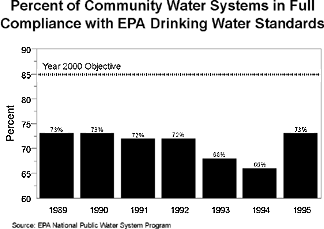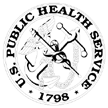
The Acting Assistant Secretary for Health
chaired a review of progress on objectives for environmental
health. This is the third round of reviews on the 17 objectives
within this Healthy People 2000 priority area. The National
Institutes of Health and the Centers for Disease Prevention and
Control, as co-leads on Environmental Health, led a discussion
which focused on drinking water safety. The status of the
objectives was as follows:
11.1 The rate of asthma hospitalizations
was 194 per 100,000 people in 1995; this is higher than the 1987
baseline of 188 per 100,000. The year 2000 target is 160.
Hospitalizations in 1995 also showed increases over the baselines
for 2 special population groups--Blacks and other non-whites, and
children aged 14 and younger.
Asthma accounts for 1 percent of all
hospitalization costs in the United States, amounting to $56
billion annually. It has a disproportionate impact on people in
the inner-city, especially children.
11.2 In 1991-92, the prevalence of
serious mental retardation (IQ<50) among school-aged children
was 4 per 1,000, an increase over the 1985-87 baseline of 3.1.
The year 2000 target is 2 per 1,000.
11.3 The number of reported outbreaks of
waterborne disease from infectious agents and chemical poisoning
declined from the 1988 baseline of 16 to 11 in 1994, thus meeting
the year 2000 target. For people served by community water
systems, there were 5 reported outbreaks in 1994 (1988 baseline =
4). The target is 2.
11.4 The prevalence of blood lead levels
exceeding 15 micrograms per deciliter among children aged 6
months through 5 years declined from the 1984 baseline of 3
million to 274,000 in 1992-94; this surpasses the year 2000
target of 300,000. The reduction of blood lead levels in children
has been one of the most significant achievements in
environmental health in recent years. A unified approach among
all levels of government and the private sector contributed
greatly to this major public health success.
11.5 In 1995, 67.1 percent of the
population lived in counties that had not exceeded Environmental
Protection Agency (EPA) air quality standards for the 6 criteria
pollutants (ozone, carbon monoxide, nitrogen dioxide, sulfur
dioxide, particulates, and lead) in the previous 12 months. The
year 2000 target is 85 percent.
11.6 In 1994, an estimated 11 percent of
the nation's homes had been tested for radon concentrations. The
year 2000 target is 40 percent. An estimated 8.8 percent of homes
with smokers and former smokers and 13.1 percent of homes with
children were tested. The target is 50 percent for each of these
special population groups. According to the National Cancer
Institute, up to one-tenth of U.S. lung cancer deaths may be
caused by radon in homes.
11.7 In 1994, 0.17 billion pounds of
toxic agents on the HHS list of carcinogens were released from
industrial facilities. This is higher than the year 2000 target
(0.12 billion pounds), which calls for a 65 percent reduction
from the 1988 baseline of 0.35 billion pounds, but progress
towards the target continues to be made. Some 1.02 billion pounds
of substances on the Agency for Toxic Substances and Disease
Registry (ATSDR) list of the 275 most toxic chemicals were
released in 1994. This reduction of more than 50 percent from the
1988 baseline of 2.15 billion pounds surpasses the target of 1.08
billion pounds.
11.8 To reduce human exposure to solid
waste contamination, a year 2000 target of 4.3 pounds was set for
the average number of pounds of municipal solid waste produced
per person per day (3.2 pounds after recycling or composting). In
1995, the average was 4.4 pounds before and 3.4 pounds after
recycling.
11.9 In 1995, 73 percent of community
water systems met safe drinking water standards established by
the EPA, the same proportion as in 1988. The year 2000 target is
85 percent. The proportion has remained relatively constant over
the years largely because EPA has continued to issue additional
Maximum Contaminant Level standards.
11.10 In 1994, there were increases over
1992 baselines in the proportions of surface waters supporting beneficial uses (i.e., fishing and recreation) in all categories
except for estuaries supporting consumable fish, for which there
was a 2 percent decline.
11.11 Nine percent of people with houses
built before 1950 reported in 1993 that the house paint had been
analyzed for lead content, an increase from the 1991 baseline of
less than 5 percent. The year 2000 target is 50 percent.
11.12 In 1993, there were three States
in which at least 75 percent of local jurisdictions had adopted
construction standards and techniques that minimize elevated
indoor radon levels. The 1989 baseline was 1 State and the year
2000 target is 35 States.
11.13 Federal regulations were
promulgated in 1996 which require disclosure of lead-based paint
in all pre-1978 housing during sales or leasing. This achieves
the year 2000 target. The number of States requiring that
prospective buyers be informed of radon concentrations in
buildings offered for sale increased from 1 State in 1989 to 25
States in 1995. The target is 30.
11.14 Ninety percent (n = 253) of the
ATSDR cease/reduce exposure recommendations were followed among
the 1,232 hazardous waste sites on the National Priority List in
1995. The year 2000 target is 100 percent.
11.15 Forty-six percent of the
population was served by curbside recycling projects in 1995, an
increase from 26 percent in 1991. The year 2000 target is 50
percent.
11.16 In 1996, Federal funds for
childhood lead poisoning surveillance were used in 27 States.
Systems to track additional sentinel environmental diseases
defined by this objective are in varying stages of development.
11.17 The proportion of children aged 6
and younger who are regularly exposed to tobacco smoke at home
declined from 39 percent in 1986 to 27 percent in 1994. The year
2000 target is 20 percent.
H I G H L I G H T S
- One third of Americans live in an area
where, in 1995, the air was too polluted to meet health
standards.
- One in 4 Americans lives within 4 miles of
a Superfund site.
- Eating one fish from contaminated water is
tantamount to drinking 1000 gallons of that water.
- Aquifers from which much of the Nation
draws its drinking water are shrinking faster than they
can be replenished. As this happens, they become
increasingly vulnerable to toxic contamination.
- The Safe Drinking Water Act amendments of
1996 require water supply systems to file annual reports
informing users about the origin and purity of their
drinking water. The law also increases State flexibility,
strengthens the EPA's scientific work, and provides a
$1.2 billion appropriation for State loan programs for
facilities that treat drinking water.
- In its "Environmental Goals for
America" initiative, the EPA has embarked on a
long-range, cooperative effort addressing 12 national
goals in areas such as air quality, drinking water,
ecosystems, toxic-free communities, and solid waste
management. Progress will be measured against the
"milestones for 2005."


F O L LO W- U P
- Work through the Environmental Health
Policy Committee (EHPC) to strengthen collaboration with
the Environmental Protection Agency (EPA), Department of
Agriculture, Department of Housing and Urban Development,
and other Federal agencies. Model our efforts in such a
way as to identify opportunities for collaborations at
State and community levels. To further collaboration, pursue
another meeting of the regional EPA officials and the HHS
regional health administrators.
- Identify critical gaps in our knowledge
about the health effects of environmental hazards and
develop strategies to address these needs.
- Work with EPA and the EHPC to better
coordinate HHS and EPA environmental health data systems
and surveillance activities to produce more useful
information. Invest in analysis and use of these data so
as to improve understanding of the health effects of
environmental hazards. Look towards the development of a
data set on sentinel events that could be widely used at
Federal, State and local levels.
- Work to more effectively communicate
issues to the public about water supply safety. Identify
those individuals in the Department to serve as resource
people on drinking water safety for State and local
public health and environmental agencies and include
their names on the EHPC homepage. Look for opportunities
to bring Federal, State, and local public health
officials together with water suppliers and environmental
agency regulators to create working relationships before
crises develop.
- Work on Healthy People objectives for 2010
that address human exposure to contaminants and other
risks to health. Work with EPA on their milestones for
2005 to ensure that, to the extent possible, objectives
can be made synchronous with Healthy People and the
2005 targets are on a trajectory compatible with targets
for 2010. Whenever EPA and HHS pursue different
objectives, acknowledge and explain these differences,
especially to State and local public health and
environmental agencies.
P A R T I C I PA N T S
Administration for Children and Families
Agency for Toxic Substances and Disease Registry
Centers for Disease Control and Prevention
Environmental Protection Agency
Indian Health Service
Milwaukee (WI) Department of Health*
National Institutes of Health
Nebraska Department of Health**
North Carolina Division of Environmental Health**
Office of Disease Prevention and Health Promotion
Office on Women's Health
Pan American Health Organization
Regional Health Administrator - Region VI
Tri-County Health Department ( Denver CO)*
* Also representing National
Association of County and City Health Officials
**Also representing Association of State and Territorial Health
Officials


Jo Ivey Boufford, M.D.
Acting Assistant Secretary for Health
Back to Progress Review Page